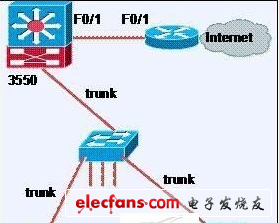There are many things worth learning about layer 3 switches. Here we mainly introduce the role of layer 3 switches in VLAN communication. VLANs are mainly built on the basis of switches, but in the absence of layer 3 switches, how to use routers to solve VLAN What is the problem of inter-communication? This article is explained through practical cases.
The second layer switch works on the second layer (data link layer) of the OSI reference model. The main functions include physical addressing, network topology, error checking, frame sequence, and flow control. In order to improve the performance of switches, manufacturers have introduced Layer 3 switches, which have added many new functions on the premise of retaining all the functions of Layer 2 computers, such as VLAN routing support, link aggregation support, and even Has the function of firewall and so on. This article describes how to use old routers to solve the problem of communication between VLANs without a Layer 3 switch.
What should I do if the first and third layer switches are broken?
Nowadays, the methods for implementing inter-VLAN routing are switches that use an integrated routing processor. In this case, the route processor is located on a line card in the switch chassis. The latest aggregation layer switch trend is to integrate the routing processor on the same module as the switching engine. The backplane of the switch provides the communication path between the switching engine and the routing processor. Because the routing processor is directly connected to the back of the switch, this allows the router to be more tightly integrated into the switching process. This not only simplifies configuration, but also provides intelligent communication between Layer 2 and Layer 3 in the network.
In addition, since this scheme provides a link with a higher rate than the external trunk, the performance is also improved. Two examples of switches that use internal routing processors are switches that use RSM, and the rate of inter-VLAN switching can reach 175Mpps (million packets per second); and switches that use MSFC2 technology, the rate of inter-VLAN switching can reach 210Mpps, The following is a networking solution using Cisco Layer 3 switches as an example, which can easily achieve routing access and Internet access between VLANs. In this case, what if the Layer 3 switch breaks down? One is not over! There are three factors that prevent Layer 3 switches from returning to this network so quickly:
1. The price of the three-tier switch is relatively expensive. Even buying a second-hand CISCO 3550 costs more than 10,000 yuan.
2. If it is a government or an institution, it may require declaration → approval → inquiry → purchase confirmation → supplier signing a contract → user receiving equipment → feedback to the unit responsible for procurement → engineering construction, etc., a long process.
Second, problem analysis (Router-on-a-STIck function introduction)
As we mentioned earlier, Layer 3 switches actually add router modules to Layer 2 switches. This is a physical method. If you want to add a router externally, let the router replace this function to replace the Layer 3 switch to implement routing between VLANs. Using this method can effectively use the existing equipment.

Technically, as long as the Ethernet interface of the router supports the VLAN Trunking function, the link between the router and the switch can be set as a Trunk to transfer the data flow of all VLANs. After dividing the Ethernet interface of the router into An equal number of sub-interfaces, each sub-interface is connected to a VLAN, this method is called "Router-on-a-STIck", as shown in Figure 1.
Many router products support this solution called "single-arm routing". If the current router does not support this technology, we can immediately buy an old router at a price of only a few hundred yuan. In fact, almost all routers and switches that support the following functions support this solution? ISL or 802.1Q (both devices must support the same trunking technology); Fast Ethernet or Gigabit Ethernet (both devices must support the same rate ).
PQ 25 high frequency flyback transformer,ETD 34 high voltage transformer,240v to 12v ac transformer,EF15 LED transformer
IHUA INDUSTRIES CO.,LTD. , https://www.ihua-coil.com